Video Transcription
It should be no surprise that here at Crown & Caliber we love watches. From the most exclusive watches to quirky quartz watches we love them all. And sometimes we get so inundated with watches we forget most people don’t spend their day working around these fascinating instruments. So, we thought we’d create a Watch Basics – 101.
We’re going to go over two sections:
-
General Watch Lingo
-
Important Mechanical Terminology
And this is just scratching the surface, but hopefully it helps you understand how these amazing machines function just a little bit better. So, let’s start with General Watch Lingo. First up is Mechanical watch.
A mechanical watch is any watch that is powered by a mechanism to measure time instead of quartz. A mechanism is often referred to as a movement or caliber. We like to think of this as the engine of the watch.
A quartz watch uses a small piece of quartz crystal with an electronic signal that pulses through it, creating a consistent vibration for the quartz to measure time. Quartz watches are extremely accurate because of the high frequency in which quartz vibrates.
The two types of mechanical movements are Manual and Automatic. As the name suggests, manual watch movements, must be regularly wound to keep the watch running. While automatic movements, once fully wound can maintain their time keeping if worn regularly. A mechanical watch will have a power reserve.
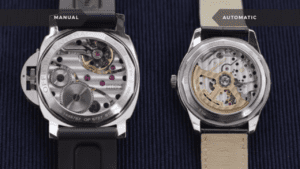
The power reserve is a measure of how long the watch will run before it stops. An average mechanical watch has a power reserve of around 48 hours. So, on a manual watch the power reserve is constantly running out which is why you need to regularly wind the watch. Now an automatic watch can maintain its power reserve because of the movement’s design. And we’ll dive a little deeper into how a mechanical watch works in a bit.
C.O.S.C.
Next up is C.O.S.C or The Official Swiss Chronometer Testing Institute. This independent organization tests the isochronism of a watch movement. Isochronism is the same principle that allows a pendulum’s swing to be equal on both sides. The process of having a movement COSC certified is as follows. A manufacturer, like Rolex will send just the movement to the Organization and they will perform a series of tests to determine if the movement is within the standards. The most recognized criteria for the certification is the average daily rate, which is -4 or +6 seconds, or up to 10 seconds per day. If the movement meets this standard, as well as the others then the movement receives the “Chronometer” certification. The movement is then returned to the manufacturer and assembled into a watch.
The C.O.S.C. term is often misunderstood. The organization does not guarantee the movements abilities after the test, rather that at the point in time when it was tested it was able to maintain the standards. Think of it this way: For a car to be able to travel at 55 mph for 8 hours then the car needs to be over-engineered to achieve this feat and watch movements are similar in that as well. It’s also worth mentioning a watch that has the “chronometer” certification will not always operate within these standards and that is completely okay. Again, the COSC certification simply means that a movement met the criteria at one point in time.
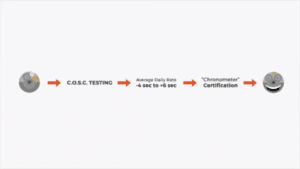
Now let’s take a look at some of the more common mechanical terminologies used in watches.
Mainspring
The Mainspring: The mainspring in a mechanical watch is the “gas tank”. The mainspring is what you wind up to start a watch. It is also the main determinant in the watch’s power reserve. A mainspring is a thin ribbon of metal that is tightly wound and rests inside the Barrel.
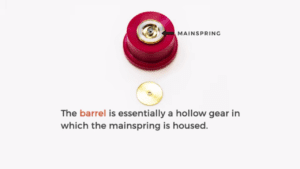
Barrel
The Barrel is essentially a hollow gear in which the mainspring is housed. When the mainspring is wound up, the barrel needs to unwind and that is where the power for the movement comes from. The power stored by the mainspring is transferred through the going train, which is a number of gears, called wheels, that lead to the escapement. A separate set of wheels coming off of the going train, called the Motion Work powers the hands of the watch.
Escapement
The Escapement is what ultimately prevents the mainspring from just unwinding all at once. It is made up of a few parts. The escape wheel, which looks like a funky shaped gear and the pallet fork which catches onto the escape wheel preventing it from just unwinding. The pallet fork clicks back and forth, allowing the escape wheel to rotate a little bit every time the pallet fork moves.
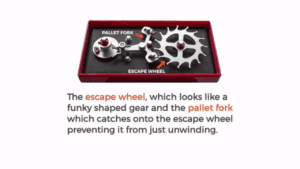
Hairspring and Balance Wheel
The hairspring and balance wheel are the heart of the movement. Together they create the “measure of time”. The hairspring is a very delicate spring that creates torsion that allows the balance wheel to return to center. The balance wheel is the outermost weighted ring of the hairspring that uses inertia to swing back and forth. The back and forth oscillating allows the pallet fork to “click”. The Impulse Pin is attached to the balance wheel and is what catches the pallet fork. Now this is a basic understanding of how a mechanical watch runs, and what each of the main parts are called. Here are a few more mechanical terms worth knowing about a watch movement.
Bridge
The Bridge: The bridge refers to a piece of metal, often brass, that the gears sit in. It’s essentially the chassis of a watch. The average watch movement will have around 5 bridges.
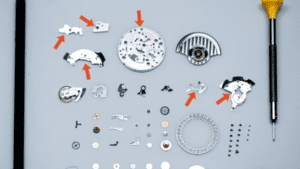
Jewels
Jewels refer to the tiny pieces of synthetic sapphire and ruby that serve to make watches more accurate. They can be found in a few places in a mechanical watch. Jewel bearings are at the center of most gears creating the lowest possible amount of friction. These can often be seen on a movement as tiny ruby colored circles. Jewels are also found on the tips of the palate fork and the impulse pin. They are used here because they reduce wear on the movement and lower friction to improve efficiency.
Oscillating Weight
The Oscillating Weight: The Oscillating Weight is the mechanism that automatically winds the mainspring in an automatic movement. Often this will be a half circle weight that uses the motion of the wearer, combined with gravity to wind the watch.
So, there’s our breakdown of General Watch Lingo and some Important Terminology, and this wraps up Watch Basics 101. Let us know if there is something you’d like us to dig into a deeper. And as always thanks for watching.
Get More Articles Like This in Your Inbox
We're constantly creating great content like this. So, why not get it delivered directly to your inbox? By subscribing you agree to our Privacy Policy but you can unsubscribe at any time.






